Original
Japanese Cartridge Boxes
8mm Nambu cartridge boxes
Most
8mm Nambu ammo came in 15 round cardboard boxes designed so that two such boxes
would fit into the ammo pouch on a Type 14 holster. The boxes were about
81mmX20mmX33mm. Generally Japanese ammunition boxes did not specify the
calibre, but rather the type of gun the contents were intended for. Thus, most 8mm
ammo is labeled as gType 14 ammunitionh, with a small amount labeled gType 94
ammunitionh. The two were, of course, interchangeable, though there is some
evidence the loading may have been slightly different. Boxes also indicated the
arsenal of production. Earlier boxes had a lot of information on the back about
lot numbers, date of production, etc. This eventually was simplified to just a
date stamping. I have recently purchased one original 8mm cartridge box, which
is shown below. The rest of the photos are provided here through the generosity
of an American friend, Mr. Dale Crabtree. Many variations exist. Here are just
a few.
Type
14-Tokyo Second Arsenal
Tokyo
Second Arsenal cartridge boxes are generally older and scarcer than those from
Tokyo First Arsenal. Here is a picture of the top of a box. At the far left is
the arsenal symbol, which is supposed to represent a flaming bomb.

(Photo courtesy of the Dale Crabtree Collection)
This
close-up shows the writing more clearly. The large line of characters in the
centre says: ju-yon-nen-shiki-ken-ju-jip-po
(ju-go-hatsu), or gType 14 handgun ammunition (15 rounds)h. The small line
of type at the top says Showa 10 nen 3 gatsu , meaning gShowa 10 year 3
monthh, or March, 1935. (Showa is the name for Emperor
Hirohitofs reign; add 1925 to a Showa year to get the year according to the
Western style calendar). The bottom line starts with the character yaku, short for kayaku, or gunpowder, indicates the year and month as Showa 9, 7th
month, or July, 1934, and ends with ita (gsheth or
gtrayh) number 50. My best guess is that the gtrayh is probably a reference to
what we would call a batch number.

(Photo courtesy of the Dale Crabtree
Collection)
The
bottom of the box is a bit more mysterious. I can read every character, but I
donft know the significance of them, except that I have read that they deal
with lot numbers, etc. Assuming these markings are to be read left to right
(see below), the first line is 9-e. E
means gfifthh, so this is ambiguous to me. All the boxes seem to have this e character, but even my Japanese
housemate is mystified by it. The second line says hachi-roku-nana, geight-six-sevenh. Then there is Western-style 8. The final
line is zero-ni-hachi, or
gzero-two-eighth.
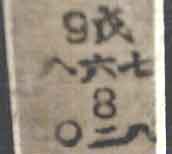
(Photo courtesy of the Dale Crabtree
Collection)
Type 14-Tokyo First
Arsenal (early type)
Here
is the top of a Tokyo First Arsenal
box made when labelling was still very comprehensive (see below for a later box
with simplified labelling). The first line of writing says: ju-yon-nen-shiki-ken-ju-jip-po, meaning
gType 14 handgun ammunitionh. The second line says gju-go-hatsuh, meaning g15 roundsh. The star is the symbol of Tokyo
First Arsenal.

(Photo courtesy of the Dale Crabtree
Collection)
Here
is the bottom of that box. At the top there are two columns of four characters
each. The right column says ju-yon-nen-shiki,
meaning gType 14h. The left column says ken-ju-jip-po,
meaning ghandgun ammunitionh. Then there is g13h and
that mysterious character e. Below
that 3-0-0-8 in Japanese characters (right to left). Then 52 (left to right) in
Western style numerals, then 0-2-8 in Japanese characters and finally the date,
Sho (short for Showa) 13.8, or
August, 1938.
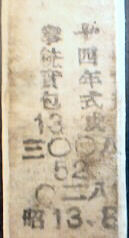
(Photo courtesy of the Dale Crabtree
Collection)
Type 14-Tokyo First Arsenal
(late type)
Later
boxes from the same arsenal had much less information on the labelling. This is
the only original cartridge box I have in my own collection so far. The first line of writing says: ju-yon-nen-shiki-ken-ju-jip-po, meaning gType 14 handgun
ammunitionh. The second line says gju-go-hatsuh,
meaning g15 roundsh. The star is the Tokyo First Arsenal symbol. In other
words, the top looks just the same as the earlier box shown above. The bottom,
shown further below, however, is much simpler.

The
box is in very rough shape, but I was glad just to find one at all. Besides,
the fact it is in broken apart in a couple of places actually allows for some
interesting study of the box construction (therefs a silver lining to every
cloud). Here is a side view.
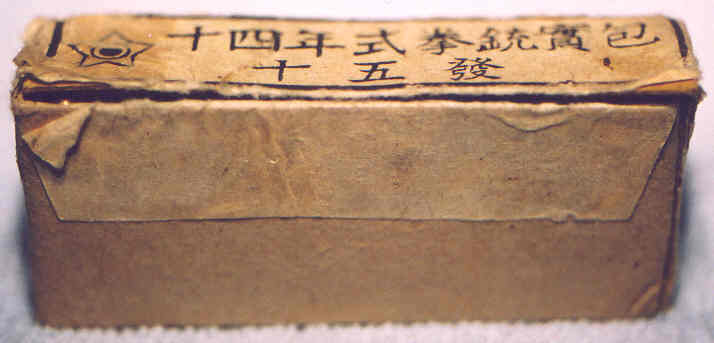
Here
is a shot of the one end.

With
the top removed you can see the strip that was attached to one end to tear the
package open. In this case it was not used and remains intact, so one can see
how it was attached.
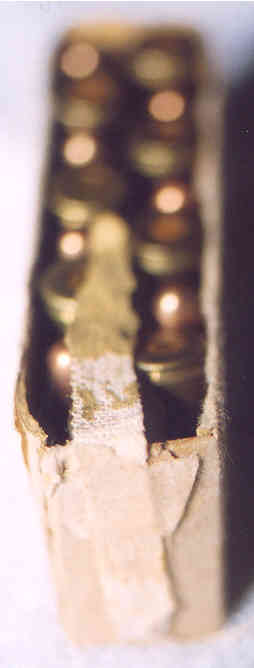
Here
is the strip from the top. The actual cloth ends about where the first
cartridge from the right in the top is primer side up. The rest is just paper
that tore off the underside of the box lid (you can see this bit of paper
missing from the underside of the lid).
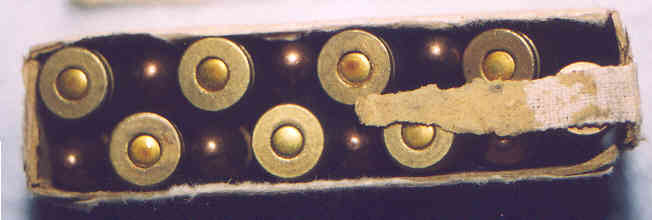
Here
is the bottom. It just says Sho 20.1,
short for Showa 20.1, or January, 1945.

This
is a close-up of the ammo in the box, which is the later, copper-jacketed type
(earlier rounds had silver-coloured cupro-nickel jackets).
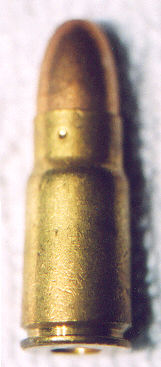
Type 94-Tokyo First Arsenal:
The
writing on the top of this box is the same as the ones above except the first
two characters are kyu-yon (94)
rather than the first three on the boxes above, ju-yon-nen (14 year).

(Photo courtesy of the Dale Crabtree
Collection)
Again
there are two columns, with three characters on the right and four characters
on the left. The right says kyu-yon-shiki,
gType 94h, while the left says ken-ju-jip-po,
or ghandgun ammunitionh. Below that 13-e, 3-0-2-3 (left to right), 33, 0-2-8 (left to right), and the date
Sho (short for Showa) 14.1, or
January, 1939. Apparently almost all boxes labeled Type 94 are dated Showa 14 (1939), although Derby & Brown
indicate that at least one dated Showa 13.12, or December, 1938 is known.
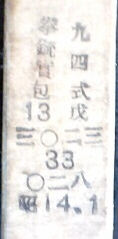
(Photo courtesy of the Dale Crabtree
Collection)
9mm Japanese revolver cartridge boxes
Ammunition
in 9mm Japanese revolver calibre was labeled gType 26 handgun ammunitionh.
Boxes held 50 rounds and were about 100mm X 50mm X 33mm. Here is a fifty-round
box from Tokyo Army Arsenal.
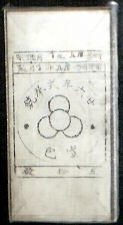
(Photo courtesy of the
Dale Crabtree Collection)
The
close-up below shows the characters on the label a bit better. The gfour
cannonballsh symbol of Tokyo Army Arsenal is in the centre. In an arc around
the top of that symbol it says from right to left ni-ju-roku-nen-shiki--ken-ju,
or gType 26 handgunh. The two characters below the symbol are jip-po, or ammunition. The bottom line
says (right to left) go-ju-hatsu, or
g50 roundsh. The top two lines are a little hard to make out, but comparing
them to a photo in a book, both read from right to left. The top one says Mei-ji-sanju-kyu-nen-ju-gatsu-chosei,
gmanufactured in October, Meiji 39h, or October, 1906. Below that is rai-kan-Mei-ji-sanju-kyu-nen-ju-gatsu-sei,
indicating the date that the primers (raikan)
were made, which was also October, 1906.
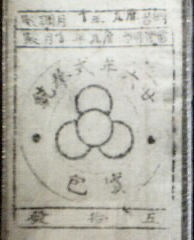
(Photo courtesy of the
Dale Crabtree Collection)
7mm Nambu cartridge boxes
Cartridges
for the 7mm Baby Nambu also came in boxes of 50. They measured 90mm X 47mm X
29mm. The symbol of Tokyo First Arsenal, the star, is in the centre of the one
shown below. The arc of writing above it reads from left to right and says ko-gata-ji-do-ken-ju,
or gsmall size automatic handgunh (the moniker gBabyh is a product of post-war
collectors; the Japanese just referred to this pistol as the gsmall sizeh. The
two characters in an arc below the star say jip-po,
or gammunitionh. The large characters across the bottom say go-ju-hatsu, or 50 rounds. Go-ju, or fifty, is written in a
non-standard way with the characters for five and zero rather than five and ten
as would be normal in Japanese.
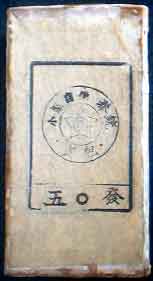
(Photo courtesy of the
Dale Crabtree Collection)
The back has a simple stamp Sho (short for Showa) 19.7, indicating
production in July, 1944.

(Photo courtesy of the
Dale Crabtree Collection)
***Many thanks to Dale Crabtree for
providing most of the photos for this section***
.32 ACP cartridge box
The Japanese manufactured ammunition in several gforeignh calibres. .32ACP (7.65mm ACP) seems to have been by far the most common, although today all such cartridges are rare. Even rarer is this original Japanese box for .32 ACP cartridges. A similar one in better condition is shown on page 298 of the Derby & Brown book.
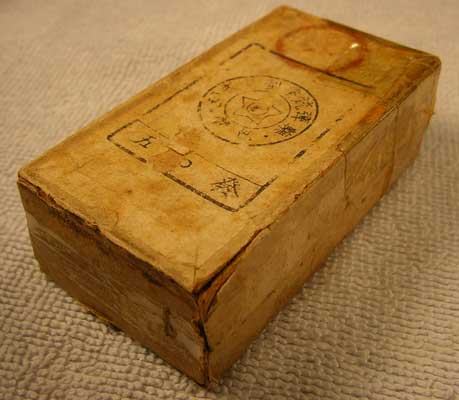
The top of the box has a now-illegible red stamp, a circular label and the line go-ju-hatsu (50 rounds) at the bottom.
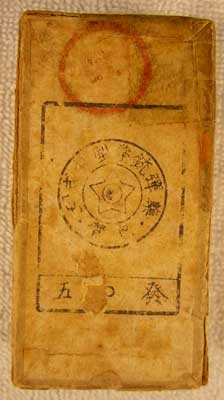
That circular label has the Tokyo First Arsenal symbol in the centre. The markings read clockwise and start about 7 ofclock, after the dot: mo-shiki-chu-gata-ken-ju-dan-yaku, i.e. gMauser-Type medium-sized pistol cartridgesh. In between the dots at 5 and 7 ofclock are the two characters jip-po, i.e. glive roundsh.

The bottom of the box is also marked.
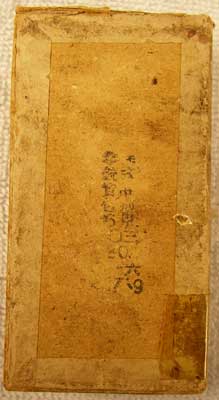
The markings have two vertical columns of four characters each at the top. They are read right column, then left column: mo-shiki-chu-gata-ken-ju-jip-po (Mauser-Type medium-sized pistol live rounds). Then there are two horizontal rows: 03, with the three written in kanji, and then 302 in Western-style numerals. The bottom two rows appear to be the date. The single character second from the bottom is Tai as in Taisho. The bottom has eight written in Kanji and nine written in Western style. This would seem to indicate a manufacturing date of Taisho 8, ninth month, i.e. September, 1919.
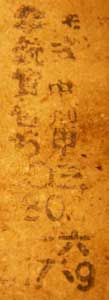
Japanese
.32 ACP cartridges had no headstamp; examples can be seen at: Original
& Collectible Ammo
Last updated: October
14, 2005. All contents are copyright Teri
unless otherwise specified and may not be used elsewhere in any form without
prior permission.
Click here to return to the Ammunition &
Reloading Page: Nambu World Ammunition &
Reloading Page
Click here to go back to the main page: Nambu
World: Terifs WWII Japanese Handgun Website